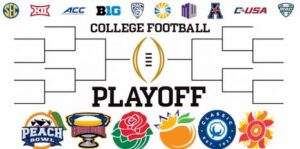Podcast: Play in new window | Download
Subscribe: RSS
Give way! The hogs are now at the trough in major college football.

The days of the four-team College Football Playoffs are officially over. The 2024 season this fall ushers in a brand new 12-team College Football playoff format.
Well, at least for the next two years. The push is already underway to expand the playoffs to 14 teams as soon as 2026.
Why stop at 14 teams? The more playoff teams, the more games to be televised. The more TV money being generated, the more revenue will go to a few college football conferences!
A brief history of college football playoffs
It may seem hard to believe, but the Associated Press’ #1 and #2 teams played against one another in a post-season bowl game just eight times in the fifty years prior to the advent of the Bowl Championship Series (BCS) in 1998.

The BCS utilized computers and the national polls to determine the top two college football teams after the traditional New Year’s Day bowl games concluded. Those two finalists faced off for the national championship one week later. During its 16-year run, the BCS system seemed to work pretty well to determine a national champion and keep most of the traditional New Year’s Day bowl match-ups intact.
Until it apparently didn’t.
In 2014, a four-team playoff system was devised. It was called the College Football Playoffs. The CFP utilized the BCS formula to determine the top four teams. It pitted the #1 team against the #4 team in one of the traditional New Year’s Day bowl games as a semifinal game and the #2 vs. #3 teams played in another. The winners matched-up a week later for the title.
The four-team CFP system (with three playoff games instead of just one) also generated hundreds of millions of incremental dollars in television rights fees paid to the major college football conferences.
If three playoff games created more revenue, why not expand the field to 12 teams?

Would someone please answer this question? “Which deserving #5-ranked team has been shafted in the past decade and left out of the four-team college football playoffs?”
The answer? No one.
Then why do we need to expand the playoffs from four teams to a dozen beginning this season?
It’s all about the money. ESPN held the sole rights to the College Football Playoffs since 2014. In recent years, the sports giant has paid more than $600 million annually for the rights to televise the two semifinals and the championship game.
ESPN wouldn’t offer that level of guaranteed payout to televise the games if they weren’t confident of selling enough advertising to cover such a hefty investment.
Beginning with the 2024 season, ESPN and the College Football Playoff group have agreed (tentatively) to a six-year contract extension through the 2030 season. In return, ESPN is expected to pay $1.3 billion each year for the rights to the new 12-team playoff field.
However, that new contract between ESPN and the CFP is still not signed.
This is simple math. More playoff games equal more money for the big boys!

In the past couple of years, the five major conferences (ACC, Big Ten, Big 12, Pac-12, and SEC) were pushing for this expansion of the playoff system from four to a dozen teams.
Unfortunately, one of the five conferences involved has been effectively disemboweled by three of its former partners.
Last summer, the Pac-12 lost ten of its twelve members as the conference imploded. A new television contract being offered to the Pac-12 schools contained much less revenue than expected.
So, four teams (Oregon, UCLA, USC, and Washington) bolted to the Big Ten Conference starting this football season. The Big Ten has now become an 18-team league beginning this fall.
Four others (Arizona, Arizona State, Colorado, and Utah) made a deal to join the Big 12 Conference in 2024. That made the Big 12 Conference into a 16-team football league this year.

The ACC picked-up two former Pac-12 teams (California and Stanford) along with former AAC member SMU beginning this season. The ACC now totals 17 football schools plus Notre Dame. The Irish want to remain independent in college football due to their lucrative contract with NBC. Notre Dame participates in the ACC in all other sports. The ACC desperately wants Notre Dame to become a football playing member of the conference soon.
Prior to that massive scramble, the SEC had already cut a deal to abscond with long-time Big 12 stalwarts Texas and Oklahoma. They are joining the SEC this season as it becomes a 16-team league beginning with the fall football season.
The four remaining major conferences now have 67 college football teams. Once you add Notre Dame into the mix, there are 68 major conference football teams beginning this year.
Who gets to participate in this lucrative 12-team College Football Playoff system?
I’ll give you a hint. “Oink, oink!”

The four major conferences are trying to appear benevolent by inviting just one team from outside of their exclusive club to participate in the 12-team College Football Playoffs. That means that one lucky team out of the five other conferences (American, Conference USA, MAC, Mountain West, and Sunbelt) will be invited (maybe) to participate for the big prize.

As of today, the four highest-ranked conference champions will be seeded #1-4 and receive a first-round bye. The remaining eight positions will be comprised of one “Group of Five” smaller conference team along with the seven highest ranking teams from the mega conferences.
Seeds #5-12 will play against each other (#12 at #5, #11 at #6, #10 at #7, and #9 at #8) in the first round with the top teams hosting the game in their home stadium.
The second round of games involving the final eight teams will take place during the New Year’s Day bowl games. The semifinals would follow on the next weekend.
That means that college football’s championship game is going to be pushed back into the second half of January beginning with this season.
But wait! What we REALLY need is 14-team playoff field in two years!
Just when you thought this madness was calming down, the SEC and Big Ten Conferences are apparently pushing to end the 12-team playoff in just two years by 2026. They want to create a 14-team playoff field to replace it.
Not only do the SEC and Big Ten want to increase the field by two teams, they want even more!

The SEC and Big Ten plan would guarantee themselves a minimum of three teams apiece in the 14-team field with the ACC and Big 12 getting two each. The “Group of Five” top team would make the field along with the three highest ranked remaining teams from any conference.
Will this “3+3+2+2+1+3” suggested plan satisfy the hogs at the trough?
In a 14-team format, the SEC and Big Ten want their top ranked team to receive an automatic bye in the opening playoff round (regardless of what the team’s rank actually is at the time of the playoff team selection). For example, Georgia might be the top SEC team in 2026 with a #3 ranking, but the Dawgs would still get an opening round bye in the current proposal.
That means if the Big 12 Conference and ACC had the #1 and #2 ranked teams at the end of the regular season, too bad! Only the highest rated SEC and Big Ten teams would receive a week of rest during the opening round.

Needless to say, the schools which don’t play in the SEC and Big Ten think it is a terrible idea.
Oklahoma State football coach Mike Gundy of the Big 12 had some choice words about this concept last week.
“A playoff format that guarantees a first-round bye to any team, division or conference before the season starts is unheard of in any sport as far as I’m aware,” said Gundy. “Based on the premise proposed, a team could be undefeated and ranked No. 1 in the country and still not receive a first-round bye because teams were rewarded one before the season even began.”
Defending his position, SEC Commissioner Greg Sankey reminded the media that his conference has provided 40% of the College Football Playoff participating teams over the past decade. He wants to insure a similar revenue share in any future playoff model.
Oink! Did anyone bother to ask college football fans how we felt about this expansion?

Speaking only for me, I was happy with the original format from the late 1990’s which featured the top two teams being selected to play on the week after New Year’s Day. Those simpler times produced a fine champion, but they apparently didn’t line the pockets of the big conferences and their television partners enough.
The major conferences and their television cohorts really don’t care what fans (or the players) think. The biggest conferences make a lot more money (to pay their players, coaches, and athletic departments) by stretching the season into more games with bigger payoffs.
As long as ESPN and other television networks are willing to pay-up for the rights to televise additional playoff games, the greedy lords of major college football and television will continue to push the limits until they pop their own lucrative bubble.

Did someone just say we needed a 16-team playoff? Oh, wait! You meant to say 32 teams, right?

